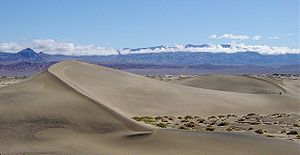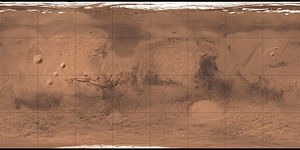Olympia Undae
| Erg on Mars | ||
|---|---|---|
| Olympia Undae | ||
|
|
||
| position | 81 ° N , 180 ° E | |
| expansion | 1100 km | |
Olympia Undae is a huge field of dunes in the north pole region of the planet Mars . This extraterrestrial erg lies between 78 ° and 83 ° north latitude and girdles the north pole plane Planum Boreum from 120 ° to 240 ° longitude . It is the largest contiguous dune field on Mars and is up to 1,100 kilometers wide - comparable in its surface area of 480,000 square kilometers with the Rub al-Chali on the Arabian Peninsula, the most important active erg on earth.
etymology
Olympia Undae ( Olympic waves ) is derived from the Greek cult site Ὀλυμπία or from the mountain of the gods Ὄλυμπος (Olympus) and from the nominative plural of the Latin unda with the meaning wave . The International Astronomical Union (IAU) has officially adopted the term Undae to denote wave-like, dune-like landforms on extraterrestrial planets.
description
Olympia Undae forms part of the Olympia Planum (formerly Olympia Planitia ), which adjoins the Planum Boreum, which lies beneath the North Pole Cap, to the south . The dune field is on average 4250 meters below reference zero. Near its geographic center is the Jojutla impact crater (at 81.63 ° North and 169.65 ° East), which has a diameter of 19 kilometers. Its name goes back to Andres Eloy Martinez Rojas, a Mexican astronomer and scientific writer. In Olympia Undae there are a number of aeolian structural forms, for example sand sheets ( English sand sheets ), transverse dunes (predominant), simple barchans , giant barchans and complicated, barchanoid ridges. All of these terrain forms also occur on earth.

Barchans are crescent-shaped single structures, the pointed ends of which point downwind. They arise in areas with thin sand cover or with a low to moderate supply of sand. Small, simply shaped barchans and giant barchans are common on the edge of Olympia Undae. Barchanoid ridges are broad, straight to winding collections of sand. They emerged from the lateral overlapping of individual barchans and suggest an increased supply of sand. When there is plenty of sand, transverse dunes form - long, barchanoid ridges with relatively straight segments that run perpendicular to the wind. Transversal dunes make up the bulk of Olympia Undae. The distance between their individual backs can be 200 to 800 meters. Comparable transverse dunes on earth are 10 to 25 meters high.
On earth, sand dunes are created by the jumping movement of grains of sand ( saltation ) in the wind stream. With the help of this premise and taking into account the much thinner Martian atmosphere and lower gravity, scientists can infer the grain size in the sand dunes of Olympia Undae. The easiest grain size to set in motion on Mars is 100 μm ( fine sand ). Olympia Undae's sand is very dark in color and is likely made of basalt . The surface of Olympia Undae shows in the thermal emission spectrometer TES a clear spectral signature of type 2, which indicates basaltic andesite , weathered basalt and / or basaltic glasses.
The total sediment volume in Olympia Undae is determined by Zuber et al. a. (2009) estimated at 10,000 ± 3,000 cubic kilometers.
Gypsum deposits

In 2005, Mars Express's OMEGA probe discovered high concentrations of gypsum in the eastern part of Olympia Undae (centered around 244.5 ° longitude and 80.2 ° north) . Data from the Mars Reconnaissance Orbiter (MRO) CRISM probe suggest that gypsum concentrations are higher at the dune ridges than in the sinks. The question of where the plaster comes from has not yet been clarified. Gypsum is an evaporite mineral that precipitates out of saline solutions. Its presence indicates changes in environmental conditions in the past of the planet Mars. Gypsum can develop from the melting of acidic snow or melting with the subsequent mobilization of sulphate-containing solutions at the base of the North Pole cap. However, the presence of gypsum does not necessarily require large accumulations of water, such as in Playa lakes , for example . It is entirely possible that the mineral formed in the volcanically heated surface groundwater and was then enriched by wind erosion and aeolian redistribution processes.
stratigraphy
The erg of Olympia Undae forms the stratigraphic Undae unit lApd (formerly Olympia Undae unit ), which has a late Amazonian age and also occurs in other circumpolar dune fields such as Abalos Undae . In the north, the Undae unit overlays the mid to late Amazonian layer deposits of the North Pole Cap unit Apu and in particular its basal unit BU, which is occasionally exposed between dunes. To the south it covers the rough Hesperian constructs of the Scandia Cavi (unit Hpe ) as well as the late Hesperian (unit lHl ) and Middle Amazonian (unit mHl ) lowland units of the Vastitas Borealis .
Individual evidence
- ↑ Olympia Undae in the Gazetteer of Planetary Nomenclature of the IAU (WGPSN) / USGS
- ^ N. Lancaster, R. Greeley: Sediment Volume in the North Polar Sand Seas of Mars . In: Journal of Geophysical Research . 95 (B7), 1990, pp. 10,924 .
- ↑ H. Tsoar, R. Greeley, AR Peter Friend: Mars: The Northern Polar Sea sand and Related wind patterns . In: Journal of Geophysical Research . 84 (B14), 1979, pp. 8167 .
- ↑ JFRussell, CW Snyder, HH Kieffer: Appendix: Origin and Use of Martian Nomenclature . In: HH Kieffer u. a. (Ed.): Mars . University of Arizona Press, Tucson 1992, pp. 1313 .
- ↑ P. Christensen et al. a .: New Insights About Mars From the Creation and Analysis of Mars Global Datasets . In: JMARS MOLA elevation dataset. American Geophysical Union, Fall Meeting 2007, (abstract # P11E-01) . 2007.
- ↑ a b K. L. Tanaka et al. a .: North polar region of Mars: Advances in stratigraphy, structure, and erosional modification . In: Icarus . tape 196 , 2008, p. 346 .
- ↑ a b C.S. Breed, M. Grolier, JF McCauley: Morphology and Distribution of Common “Sand” Dunes on Mars: Comparison with the Earth . In: Journal of Geophys. Research . 84 (B14), 1979, pp. 8187 .
- ↑ a b J.R. Zimbleman, SH Williams: Eolian Dunes and Deposits in the Western United States as Analogs to Wind-Related Features on Mars . In: M. Chapman (Ed.): The Geology of Mars: Evidence from Earth-Based Analogs . Cambridge University Press, Cambridge 2007.
- ^ ED McKee: Introduction to a Study of Global Sand Seas . In: USGS Professional Paper 1052 . 1979, p. 1-19 .
- ↑ a b c R. Greeley et al. a .: Martian Aeolian Processes, Sediments, and Features . Ed .: HH Kieffer u. a. Mars. University of Arizona Press, Tucson, AZ 1992.
- ^ M. Wyatt, H. McSween, K. Tanaka, J. Head: Global Geologic Context for Rock Types and Surface Alteration on Mars . In: Geology . tape 32 , 2004, p. 645-648 .
- ↑ Y. Langevin et al. a .: Sulfates in the North Polar Region of Mars Detected by OMEGA / Mars Express . In: Science . tape 307 (1584) , 2005, doi : 10.1126 / science.1109091 .
- ↑ LH Roach u. a .: CRISM Spectral Signatures of the North Polar Gypsum Dunes . In: Lunar Planet. Sci. Conf., 38th, Abstr. 1970 . 2007.
- ^ S. Byrne: The Polar Deposits of Mars . In: Annu. Rev. Earth Planet. Sci. tape 37 , 2009, p. 551-552 .
- ↑ KE Fishbaugh et al. a .: Formation of the Martian North Polar Gypsum Deposit During the Amazonian . In: Fourth International Conference on Mars Polar Science and Exploration, Abstract # 8041 . 2006 ( usra.edu [PDF]).
- ↑ KL Tanaka: Mars' North Polar Gypsum: Possible Origin Related to Early Amazonian Magmatism at Alba Patera and Aeolian Mining . In: Fourth International Conference on Mars Polar Science and Exploration, Abstract # 8024 . 2006 ( usra.edu [PDF]).


